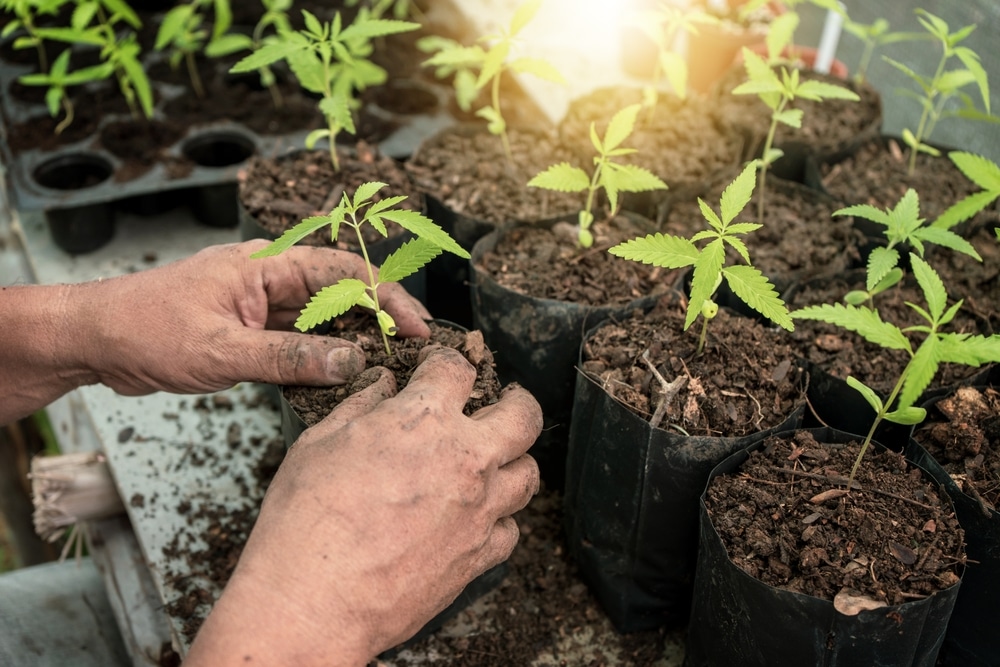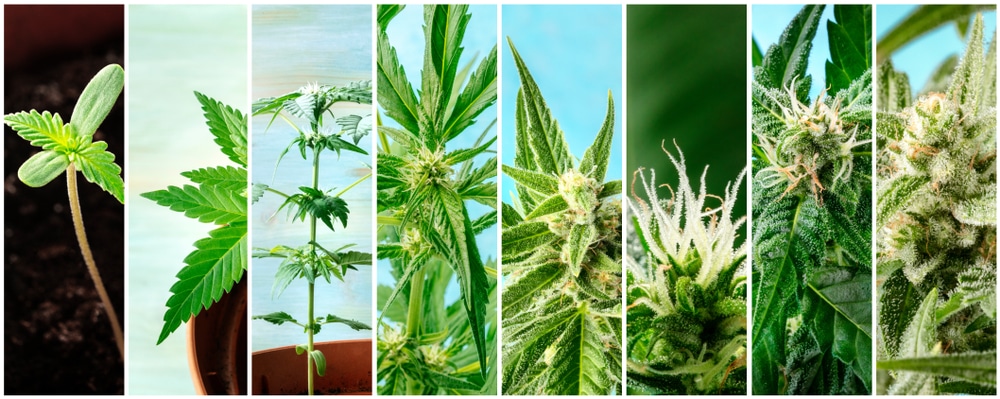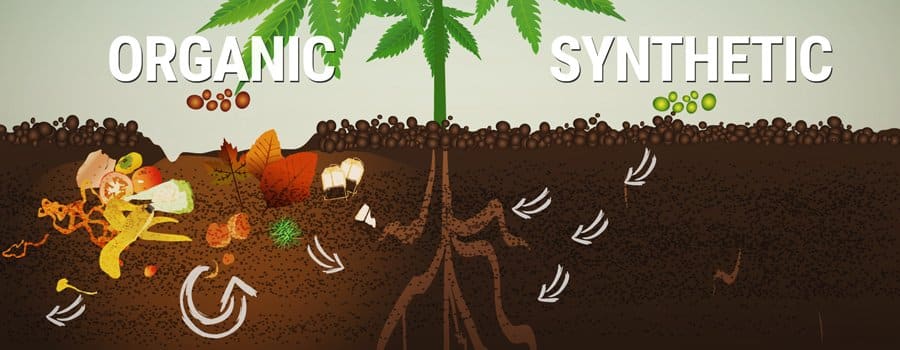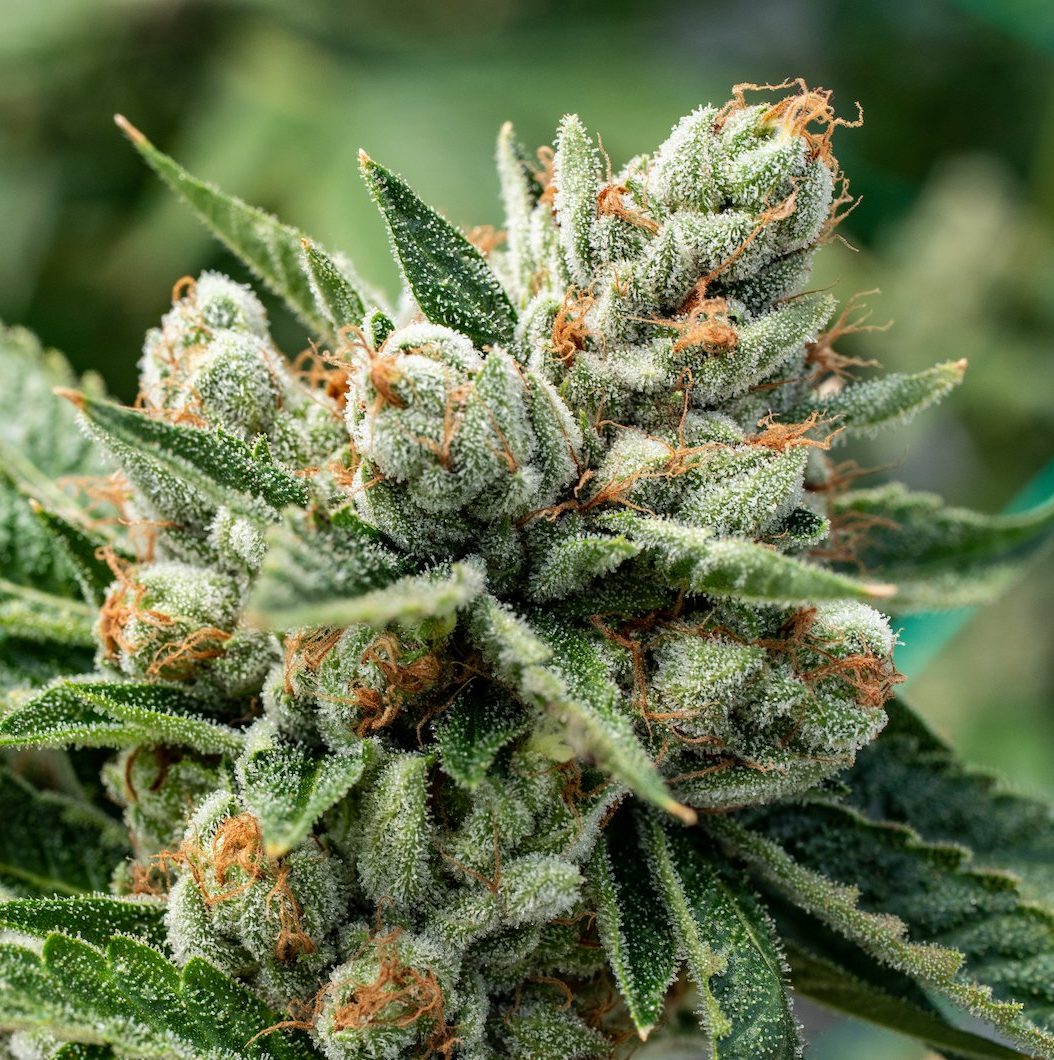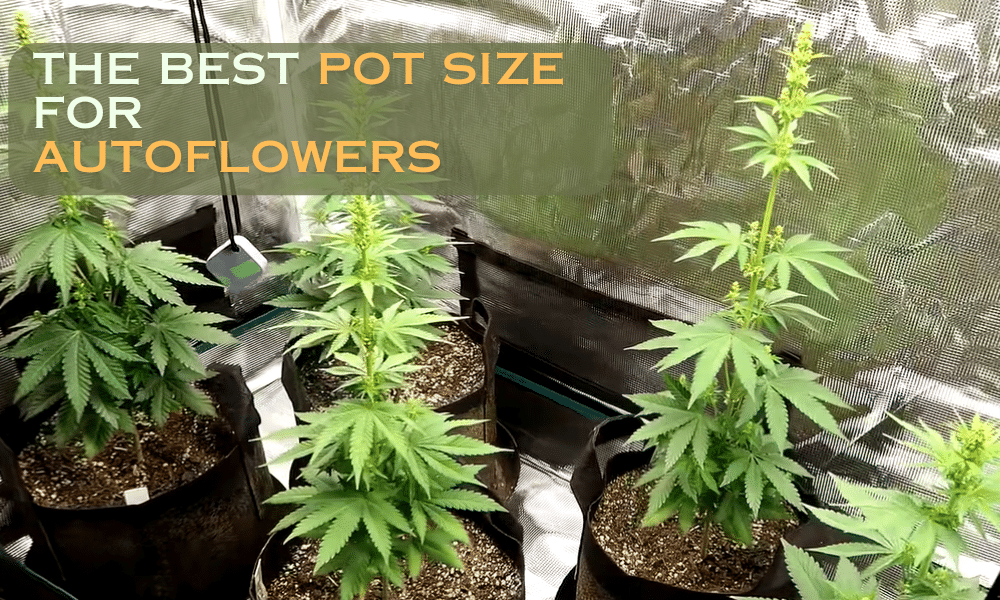No products in the cart.
Marijuana Education
Best Soil to Grow Marijuana
Do you know what the best soil to grow marijuana is? Or how it can ensure a stash of resinous, flavorful buds?
Soil houses your plants, and its quality translates into harvest size and stickiness. Picking the right type is one of the cornerstones of successful cannabis cultivation.
Join us to learn everything about soil for marijuana. We discuss why it matters, how to choose it, and how to maintain it while growing plants.
The importance of soil in marijuana cultivation
Using the best soil for marijuana plants sets you up for a successful growing operation. Let’s start by outlining its significance.
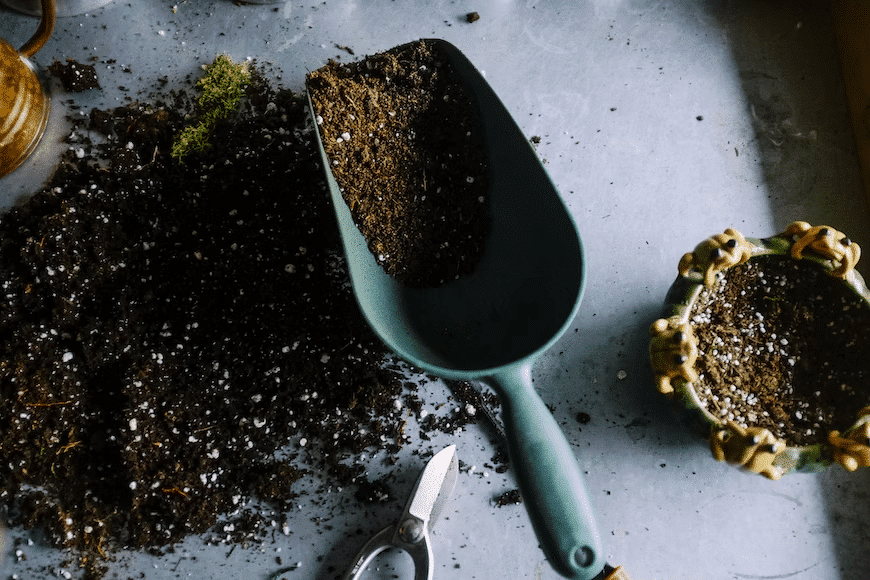
Role of soil in cannabis growth
The role of soil in cannabis growth is manifold:
- Offering structural support: The root system spreads through the soil and stabilizes the above-ground greenery.
- Providing water: Roots draw water from the soil to photosynthesize and transport nutrients.
- Providing nutrients: The soil is a nutrient reservoir. It contains the food needed for plant growth and makes it available to the roots.
- Protecting the roots: The root zone is vulnerable. The soil shelters it from unfavorable conditions and pathogens.
Understanding the connection between soil and cannabis quality
The soil lets plants feed, drink, and grow. It can make or break your cultivation efforts.
Plants can’t develop if the soil lacks nutrients or the proper pH. The roots don’t spread or consume water when the medium is too loose or packed. As a result, your weed suffers deficiencies and illnesses.
The state of your soil also correlates to the bud quality at harvest time. Malnourished, dry, or sick plants can’t produce potent, flavorful weed.
Basics of soil science
Before discussing the specifics of the best soil to grow marijuana, here’s some basic info about this medium.
Soil composition and types
Not all soils were made equal, and only some are suitable for crop production. Understanding the traits of this medium lets you fine-tune it to your weed’s needs.
Understanding soil components
Soil components include minerals, organic matter, living organisms, water, and air.
These ingredients will cooperate to accommodate marijuana. Minerals are a nutrient supply, and water sends them to the roots. The air sustains living organisms, which decompose organic matter into plant food.
Optimizing all five components creates the best soil for marijuana plants.
Differences between clay, silt, and sand
Most gardening soils consist of these three minerals:
- Sand has large particles and is easy to work with. It offers excellent drainage but poor water retention.
- Silt has medium-sized particles and plenty of organic matter. It delivers a good balance between water drainage and retention.
- Clay has small particles and many minerals and nutrients. Its density makes it good at water retention but slow-draining.
You don’t have to pick just one. Most weed growers use loam: a mixture of sand, silt, and clay. It offers optimal nutrient amounts, water retention, and drainage capabilities.
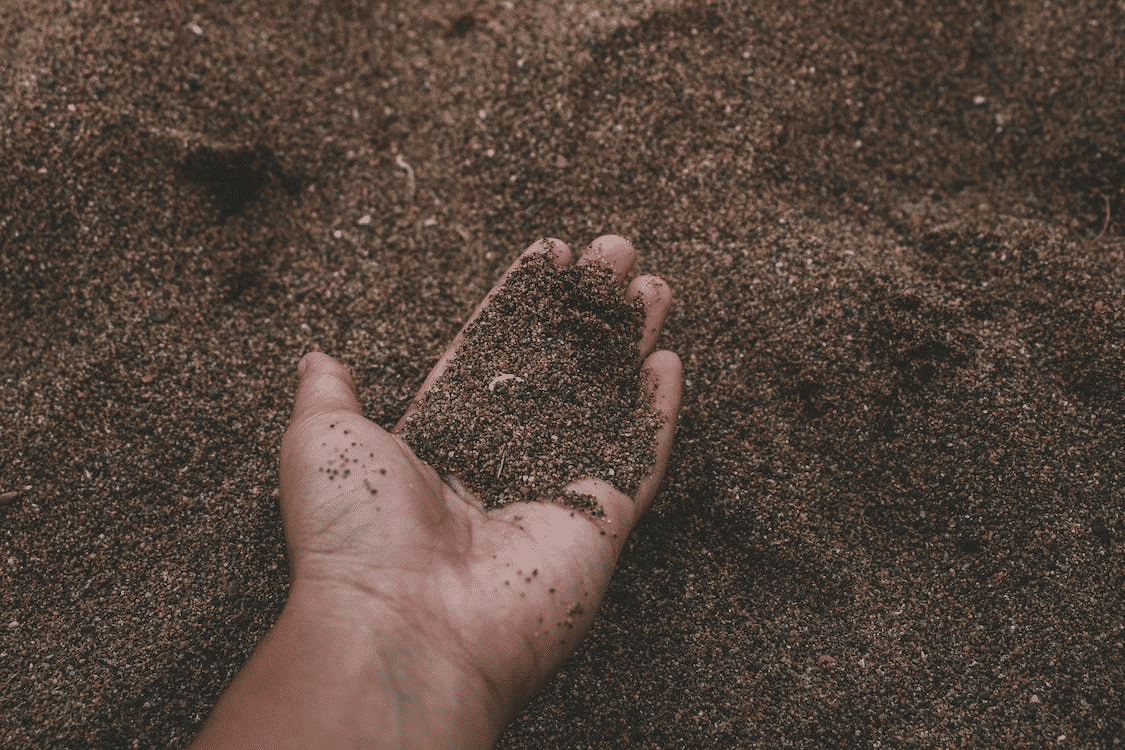
The role of pH in soil
Soil chemistry impacts plant health and well-being. Most importantly, its pH level.
The soil pH expresses the acidity or alkalinity of soil water. Since weed only consumes nutrients in slightly acidic conditions, the pH determines whether plants feed and grow.
Understanding pH and nutrient availability
Research on nutrient availability shows that nutrients become unavailable at pH values above neutral (7.0). pH imbalances starve your plants, even if plenty of food surrounds the roots. We call this condition “nutrient lockout.”
Optimal soil pH for cannabis
The optimal soil pH for cannabis is in the 6.0–7.0 range. If you want to be more precise, 6.0–6.7 is a safe bet.
Nutrients are soluble at different acidity levels, so some fluctuations are acceptable. But react as soon as possible if the pH drops below 5.8 or rises above 7.1.
The pH can change due to rainfall, plant growth, watering, and feeding. Treat your soil with pH-optimized water and nutrients to keep it within the correct range.
Selecting the best soil to grow marijuana
Loam with 40% silt, 40% sand, 20% clay, and 6.0–7.0 pH is the best soil to grow marijuana. But the mineral and pH composition aren’t the only factors at play here.
Let’s examine the types of cultivation soil to help you pick your perfect option.
Organic vs. non-organic soil
The first distinction is organic vs. non-organic soil. It determines the presence of organic material within the medium.
Organic soil contains carbon-based matter that is (or was once) alive. Non-organic soil consists of manufactured materials free of nutrients and contaminants.
Benefits of organic soil
Organic soil is sought-after because it offers these benefits:
- Increased nutrient supply: Organic matter contains nutrients for plant growth and flowering.
- Improved water retention: Organic materials behave like sponges, showcasing an excellent water-holding capacity.
- Better soil stability: Organic matter creates soil aggregates, helping it withstand water erosion.
Comparing organic and non-organic soils
Organic and non-organic soils differ in composition and suitability for plant life. The table below describes their key traits.
| Organic soils | Non-organic soils | |
| Composition | Primarily carbon-based | Primarily mineral-based |
| Fertility | Fertile: require minimal fertilization | Infertile: require fertilization |
| Nutrients | High nutrient contents | Low nutrient contents |
| Water retention | High water retention | Depends on the mineral contents |
| Structure | Well-structured, allow root penetration | Depends on the mineral contents |
Organic options generally offer the best soil for marijuana plants. They require fewer chemicals and labor to create an ideal gardening environment.
Pre-fertilized vs. unfertilized soil
Next, we have pre-fertilized vs. unfertilized. These soils differ in the presence of plant fertilizer within them.
Non-fertilized soils contain only naturally occurring minerals. They’re a blank canvas, letting you establish a cannabis feeding schedule. You use soluble nutrient solutions or organic matter.
Pre-fertilized soils contain nutrient-rich amendments, like compost and manure. They simplify your gardening journey, but only if you understand their composition.
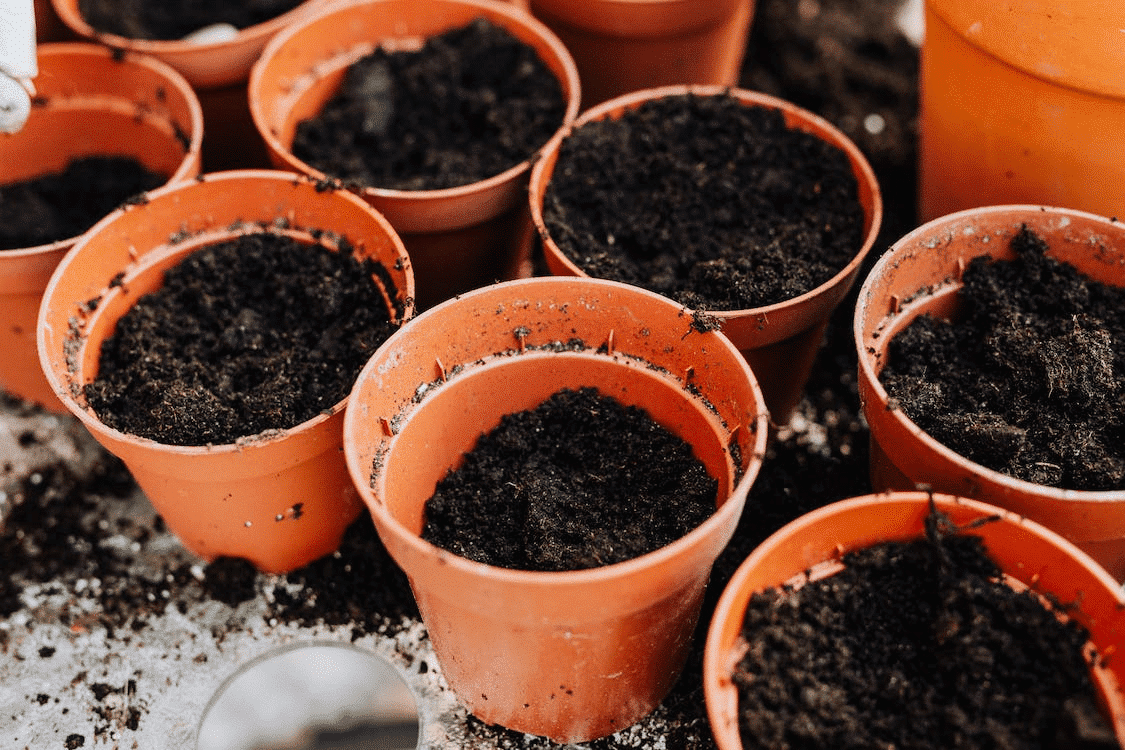
Understanding pre-fertilized soil
Pre-fertilized soil is nutrient-enriched with fertilizers or organic matter. We also call it “potting soil.”
The composition depends on the manufacturer and intended use. These soils typically supply essential micronutrients and macronutrients for cannabis. They may contain amendments that improve the structure, like perlite or peat moss.
Pre-fertilized soils give your garden a head start. They eliminate the need to feed early in the plant life cycle. Since nutrients deplete over time, you may have to fertilize in late vegging and flowering.
Pros and cons of pre-fertilized soil
Pre-fertilized soil can be an excellent way to get your garden started. Consider its pros and cons from the below table and decide for yourself.
| Pros of pre-fertilized soil | Cons of pre-fertilized soil |
| Excellent water retention | Limited nutrient control |
| pH-optimized | Short-term solution |
| All cannabis nutrients present | Quality depends on the brand |
| Saves time and effort | |
| Improves poor-quality land |
Evaluating commercial soils for cannabis
Some of the best soil for marijuana plants comes from commercial brands. These pre-fertilized blends reduce the work needed to set up your garden. But as we mentioned above, the quality depends on the brand.
Here’s what you need to know to purchase the finest commercial cannabis soil.
Popular brands and their features
Numerous soil brands are available in gardening stores. These three are cannabis growers’ favorites:
- FoxFarm is a long-standing brand that sells soil mixes and fertilizers. Many products are organic, and they offer options for vegging and flowering. Their best-selling soil contains forest products, peat moss, bat guano, and crab meal.
- Espoma Organic is another old-hand company that offers fertilizers and potting mixes. Many products contain beneficial bacteria to make nutrients available to the roots. You combine them with regular soil, meaning you need smaller quantities.
- Brut Worm Farms offers organic soil blends and worm casting fertilizers. Their super soil is a living mix with enzymes, beneficial bacteria, and natural matter. It’s pH-optimized, so it prevents nutrient deficiencies.
How to select the best commercial soil
What if you wanted to find the best soil to grow marijuana beyond these three brands? Look for commercial blends with these features:
- Water-holding capacity: Soils with good retention require less frequent watering. They include mixes rich in silt, clay, and peat moss.
- Organic amendments: These food sources slowly release nutrients, keeping your plants well-fed. Think bat guano, bone meal, kelp, and manure.
- Optimized pH levels: Cannabis enjoys a soil pH of 6.0–7.0. Choose manufacturers that specify the acidity of their medium.
Modifying and preparing the soil for cannabis cultivation
Do you want to make the best soil for marijuana plants at home? It’s possible with some know-how. You can add amendments that improve anything, from aeration to nutrient contents.
Here’s how to turn any soil into the perfect environment for weed.
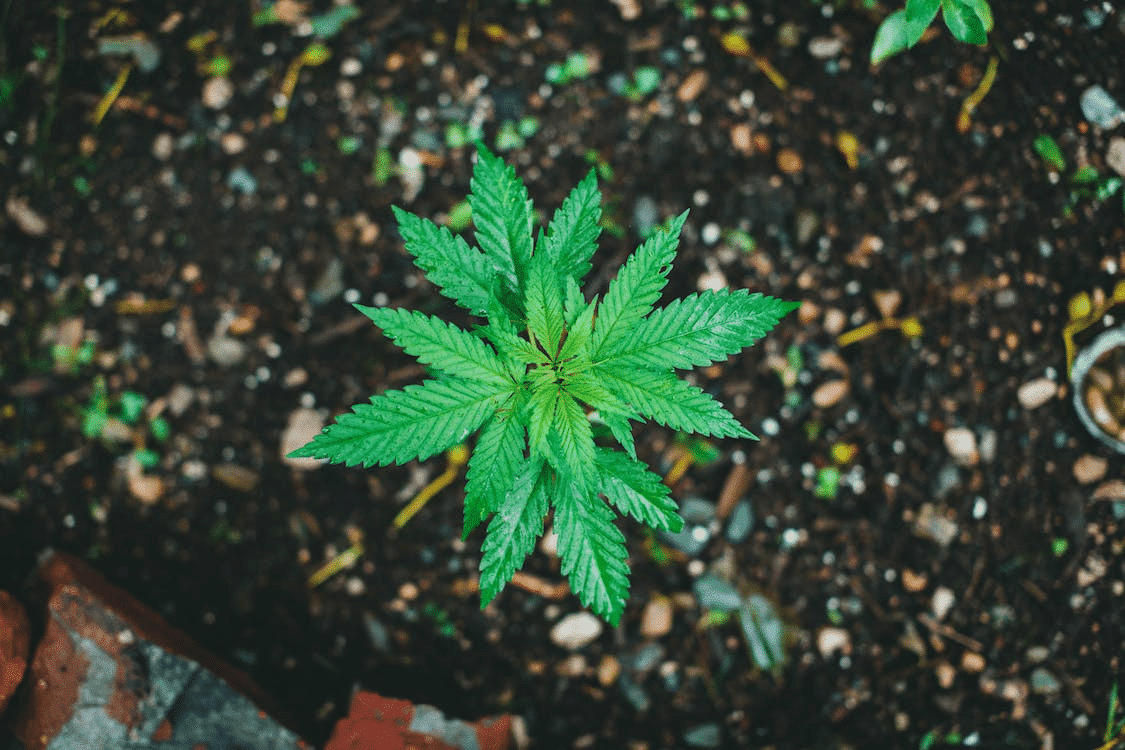
Adjusting soil texture
The soil texture affects how much air and water it can hold. It depends on the particle size of its dominant minerals.
Importance of soil aeration and drainage
Aeration and drainage describe air circulation and water movement within a medium. The best soil to grow marijuana ranks high at both these properties.
Drainage determines the rate at which water passes through the medium. When it’s good, pools don’t form around the stem during watering.
Aeration means the presence of air within the soil. When it gets compacted, the roots can no longer breathe or spread.
Materials to improve soil texture
Chances are natural land won’t have the optimal texture for cannabis. You can improve it with these amendments:
- Coco coir: Light fibers that loosen compact soils and hold water well. Add up to 30% of coco to your base medium.
- Perlite: Light white rocks that improve drainage and aeration. It works best when you add 10–15% of it to your soil.
- Vermiculite: A brown mineral that lightens soil and retains water well. Around 10% of this material is ideal.
- Clay pebbles: Brown balls that aid drainage and prevent root-rotting pooling. Add them to the bottom of your containers.
Amending soil for optimal nutrition
Naturally occurring soil nutrients aren’t enough for weed plants. You may boost them with soluble fertilizers or enrich your medium before sowing. Many growers combine these methods for the best results.
Let’s see which nutrients cannabis needs and how to provide them.
Essential nutrients for cannabis
We divide essential cannabis nutrients into macronutrients and micronutrients. Plants need large doses of macronutrients and small or trace amounts of micronutrients.
Nitrogen, phosphorus, and potassium are essential macronutrients. Plants need more nitrogen in vegging and more phosphorus and potassium in flowering.
Calcium, magnesium, and sulfur are essential micronutrients. They keep plants strong and enable photosynthesis.
Marijuana also needs trace amounts of iron, zinc, copper, manganese, boron, and molybdenum. Most soils contain these micronutrients, so supplementation is rarely necessary.
Common soil amendments for marijuana
The best soil to grow marijuana is rich in organic soil amendments. Efficient options include:
- Compost: A well-rounded nutrient source with microbes.
- Worm castings: Fast-release nitrogen and several micronutrients.
- Bat guano: Rich in nitrogen, phosphorus, and beneficial bacteria.
- Blood meal: Abundant in nitrogen and acidic, reducing soil pH.
- Kelp meal: A potassium booster that’s also rich in micronutrients.
Balancing soil pH
All the fertilizer in the world won’t matter if the plants can’t access it. That’s exactly what happens due to pH imbalances, so track this metric regularly.
Monitoring soil pH throughout the grow cycle
Monitoring the soil pH throughout the grow cycle lets you catch and correct imbalances early. So, get a pH testing kit and check this metric every time you feed your weed.
Start with a baseline soil test. Use pH meters, drops, strips, or send a sample to a certified lab.
Test the water-nutrient solution and runoff pH during weed feedings. That way, you gauge the conditions around the root zone and diagnose faults in any part of your system.
Techniques for adjusting soil pH
Techniques for adjusting soil pH include:
- pH-Up and pH-Down products: Available in most gardening stores and quickly drive the pH up or down.
- Organic matter: Natural amendments release acids and alkaline compounds as they decompose. They stabilize pH over time.
- Agricultural lime or sulfur: The former neutralizes acidity, while the latter acidifies the soil.
Maintaining soil health during cannabis growth
You’ve established the best soil for marijuana plants. But it doesn’t exist in stasis, so don’t drop the ball now.
Weed watering and feeding affect the soil, maintaining or reducing its quality. Let’s discuss ways to keep it optimal throughout your growing journey.
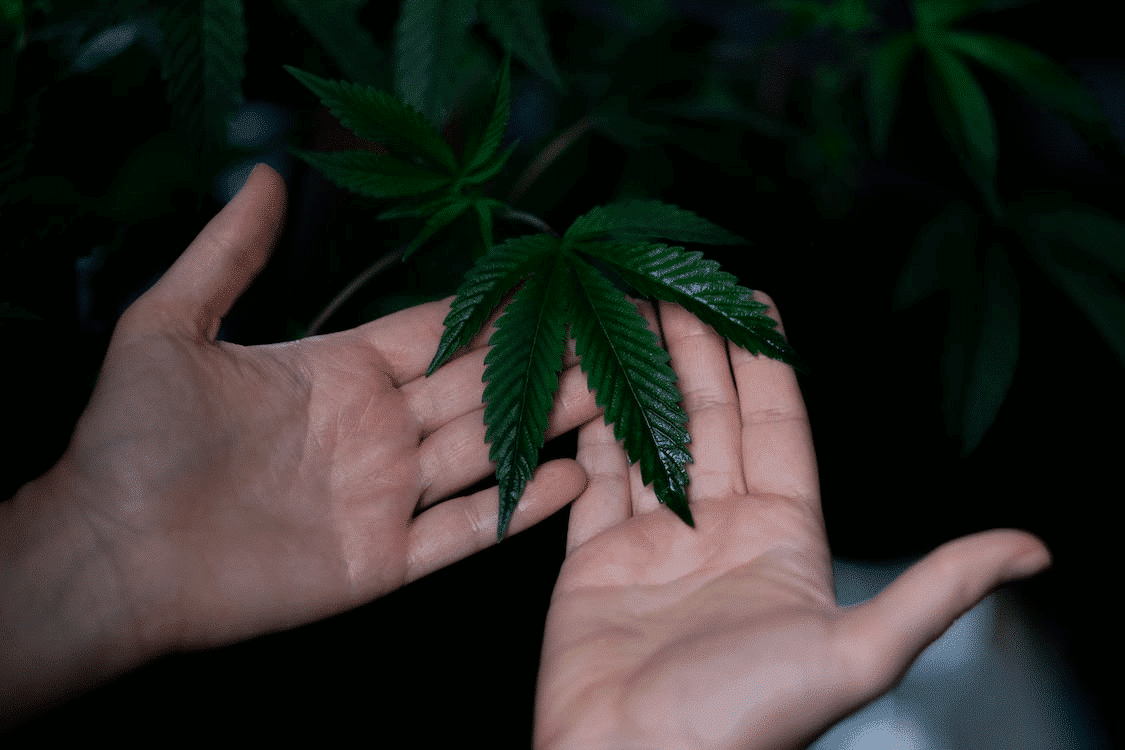
Watering practices for soil-grown cannabis
Cannabis needs water to photosynthesize, remain firm, and grow. The best watering practices depend on plant size, pot capacity, and climate conditions.
Seedlings require only light misting. The larger the plant gets, the thirstier it becomes.
Different pot sizes also call for different water amounts. You want to saturate the soil but not create mud. Aim to provide 25–35% of the container capacity.
Provide frequent watering in hot and dry climates. As a rule, water when the top inch of the soil feels dry.
Understanding overwatering and underwatering
Overwatering and underwatering are common cultivation pitfalls. They happen when weed plants get too much or too little water.
Overwatered weed leaves discolor and curl down. Excess water drains the nutrients from the medium, leading to deficiency symptoms.
Underwatered weed looks dry, limp, and lifeless. The leaves lose their thickness and bounce. This condition can also trigger deficiencies because the plants draw nutrients through water.
Proper watering techniques for different soil types
Proper watering techniques let you maintain the best soil to grow marijuana. They differ based on the type of medium you’re using.
Water around the main stem and move outward in circles. Stop if pools develop on the surface. Empty the tray of runoff to shelter your plants from pathogens.
Clay gradually absorbs moisture but retains significant amounts. So, water slowly and deeply in dense land. Liquid rushes through sand, so supply less water more often in loose soils.
Nutrient management in soil
Cannabis requires regular feeding to flourish. Nutrient management staves off deficiencies and keeps your garden healthy and prolific. Use soluble fertilizer or organic materials to meet the plants’ nutrient needs.
Start feeding your plants in the early vegetative stage. Seedlings have low appetites and are satisfied with what minerals are naturally available. Folks using potting soil can wait several more weeks.
Those with soluble fertilizers should follow the manufacturer’s dosing and frequency instructions. Start with half a dose of vegging nutrients after transplanting the seedlings. Increase it in veg and transition to flowering fertilizer when the plants bloom.
Recognizing nutrient deficiencies in soil
Nutrient deficiencies in soil-grown plants make them look sickly. Symptoms include leaf yellowing, wilting, twisted growth, and stunted development.
Don’t rush in with fertilizer yet. Nutrient deficiencies happen due to insufficient food, improper pH levels, or overwatering. Exclude the latter two before you add more nutrients.
How and when to add nutrients to the soil
There are two ways to add nutrients: slow-release organic matter or fast-acting fertilizers. You can combine them to make feeding more effective.
Timing depends on your garden’s health: add more organic nutrients if the plants look sickly. As we mentioned earlier, soluble fertilizers have frequency instructions for you to follow.
Troubleshooting common soil issues
Even the best soil for marijuana plants sometimes develops issues. It may compact due to excessive water or become a home to a pest colony.
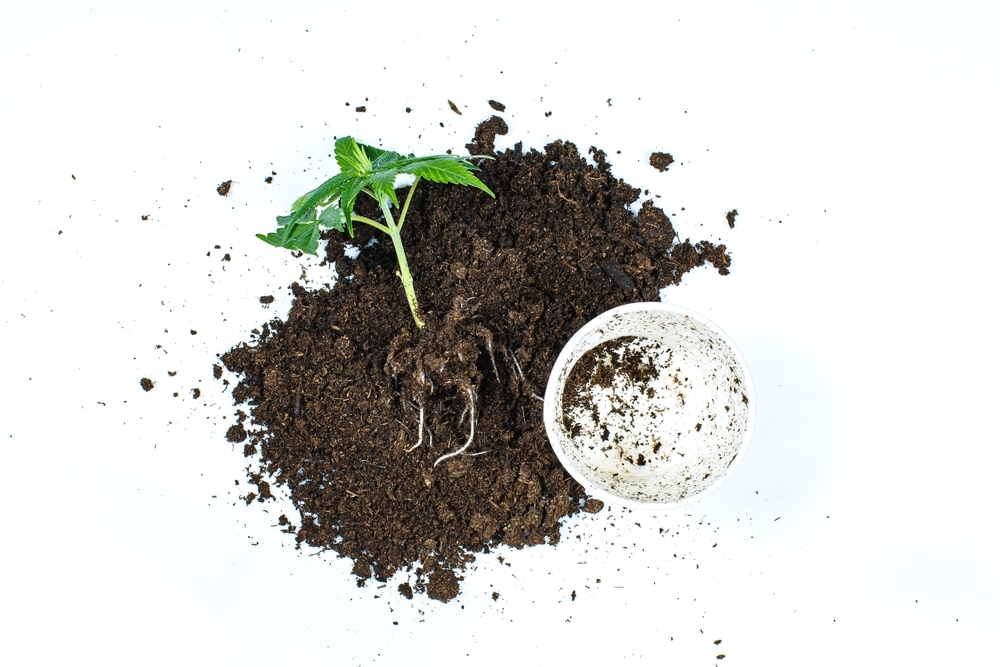
Dealing with soil-borne pests and diseases
Soil-borne pests and diseases can damage weed roots, stems, leaves, and buds. They occur due to contaminated soil and inputs and poor environmental conditions.
Check your soil, plants, tools, and amendments for contamination before using them. Excessive moisture and poor drainage also allow pathogens to enter and spread.
Common soil pests and their control
Soil houses these common pests:
- Fungus gnats: Small flying insects that lay eggs in moist soils. The larvae feed on the roots, making the plant weak and sickly.
- Spider mites: Tiny spiders that enjoy hot, dry conditions. They feed on the plant sap and cause the leaves to yellow.
- Nematodes: These slender worms attack cannabis roots. They make the root zone knot, resulting in stunted growth.
- Cutworms: Nocturnal larvae that hide in the soil during the daytime. They emerge at night, feed on weed, and damage its stems.
Enrich the soil with pest-killing life, like beneficial nematodes, rhizobacteria, and Bacillus thuringiensis (Bt). A water-hydrogen peroxide mix is a quick solution for a larvae infestation.
Managing soil diseases in cannabis cultivation
Besides pests, your soil might get infected by these diseases:
- Fusarium: A soil-borne pathogen that causes root rot and damping-off. It results in discolored foliage and dead roots.
- Pythium: An organism that thrives in moist soil. It makes the roots rot and lose effectiveness. The plants soon wilt.
- Botrytis: A fungus that causes mold infection in plants, often resulting in bud rot. It can damage the flowers and stems.
Address diseases with organic fungicides and bactericides, like alcohol and apple cider vinegar. Since most attack the roots, remove the diseased areas and transplant the rest into clean soil.
Correcting poor drainage and compaction
Compaction and poor drainage happen due to improper soil management. They may occur even in the best soil for marijuana plants.
Compaction doesn’t let the roots spread or access nutrients. Poor drainage occurs when water remains stagnant within the soil. It causes water-logging, root rot, and slow growth.
Identifying drainage and compaction issues
Drainage and compaction issues exhibit visual cues, making it easy to identify them.
Compaction causes pools to form on the soil surface. The medium may feel firm and dense.
Runoff forms slowly in poorly draining soil. It remains soggy for hours or even days, and puddles form on its surface.
Solutions for improving soil drainage and reducing compaction
Solutions for improving drainage and compaction include organic and inorganic soil amendments. Transplant your weed into a new pot upon fixing these issues for the best results.
Coarse sand and perlite increase pore space for better drainage. Compost, manure, and peat moss have similar properties (plus plant nutrients).
Conclusion
Let’s wrap things up with key takeaways and additional resources on the best soil to grow marijuana.
The art of perfecting your soil for cannabis growth
Perfecting your soil ensures your plants remain healthy, well-fed, and flourishing. Let’s reiterate ways to do so:
- Start with quality soil: Whether store-bought or homemade, it should be cannabis-optimized.
- Don’t compromise: Soil fertility, pH, and texture influence your harvests. Choose a medium that checks all boxes.
- Use amendments and additives: These materials improve soil across the board. Why hesitate to use them?
- Care for your soil well: Good watering and feeding practices equal long-term cultivation success.
Continued learning and experimentation
Soil management isn’t an exact science. No manufacturer, recipe, or tip will work 100% of the time. But soil is a forgiving medium, leaving room to experiment until you get it right.
Troubleshooting soil issues comes with time. Each pest or disease you encounter deepens your knowledge. The same goes for strain-specific requirements. Continued learning guarantees you can make any cultivar prosper.
Importance of observing and adjusting to plant needs
Weed plants show they’re not satisfied with their soil. For instance, foliage discoloration suggests inadequate nutrients. Small or wilted leaves lack water, and foul odors happen due to root rot.
The best soil to grow marijuana should adapt to each plant. So, don’t get caught up in theory and disregard your actual garden.
Recommended resources for soil management in cannabis cultivation
Our guide is comprehensive, but not in-depth. We’ve built a knowledge foundation, but many topics warrant extra exploration.
You can browse our blog to find specific guides on the topics above. Here are some additional resources for the questions we haven’t yet covered.
Useful books and online guides
These resources offer a wealth of information on soil management:
- For the Love of Soil: A complete guide on soil management for farmers.
- Marijuana Garden Saver: A brief yet comprehensive guide on plant health issues. There’s a whole section on nutrients.
- True Living Organics: The ideal book for folks who want to grow weed without any chemicals.
- Soil Health Institute: A community helping cultivation become more sustainable. The website contains many guides on all things soil.
Marijuana growing communities for support and advice
Sometimes, reading general information isn’t enough. Visit these communities to get specific input from fellow cultivators:
- Growers Network: A global cannabis community frequented by rookies and experts.
- Grasscity Forums: This smoke shop has a well-developed community of enthusiastic cultivators.
- Reddit: This website features forums about weed growing. You can find communities for everything, from hydroponics to commercial operations.
Congratulations! You’re all ready to buy weed seeds and produce the highest-quality buds.


